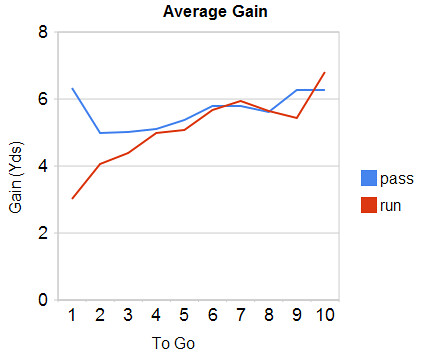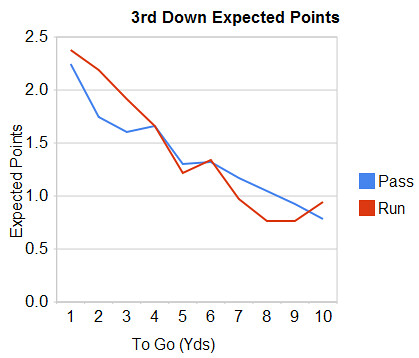 Are NFL coaches calling the right plays on 3rd down and short? In part 1, we saw that 3rd down conversion rates suggested teams should run more often in such situations, as long as getting a first down is the only goal. In this installment, I'll continue the analysis by considering two other factors--average yardage gained and expected points.
Are NFL coaches calling the right plays on 3rd down and short? In part 1, we saw that 3rd down conversion rates suggested teams should run more often in such situations, as long as getting a first down is the only goal. In this installment, I'll continue the analysis by considering two other factors--average yardage gained and expected points.
Adjusted Gain
Although conversion rates indicate teams pass too often, they're not the only measure of success on 3rd down. It’s always better to have a 1st down and more yards (except on 3rd and goal). So on one hand, passing seems to offer an advantage over running in that its average gain is longer. On the other hand, there is the chance of an interception when passing. To include both considerations in the analysis, I’ve calculated the “adjusted gain” of each play. Adjusted gain subtracts 45 yards for each interception. This method accounts for interception risk well because a 45 yard loss results in roughly the same change in expected scoring as a turnover. The graph below plots the distribution of adjusted gain for 3rd and 1 situations.
A simpler way of looking at each option is the average adjusted gain for each type of play. Here is a graph of average adjusted gain for 3rd down situations.
Until 3rd and 4 offenses are getting more adjusted yards by passing than by running. By 4 yards to go, adjusted gain equalizes. (Again, except for 3rd and short, it’s striking just how equal the adjusted gains are.) On 3rd and 1 the pass outgains the run by 3.3 yards per play, but the run gets a first down more often. The question now becomes, what would an offense rather have: an extra 12% probability of conversion by running, or an extra 3.3 yards on average by passing?
Expected Points
By comparing the expected points of both options, we can get an answer. A typical punt results in a loss of about 1.8 expected points. This is 12% more likely when passing than when running, which results in a 0.12 * 1.8 = 0.22 loss in expected points. An extra 3.3 yards is worth 0.10 additional expected points. The net difference is 0.12 points in favor of the run. So for 3rd and 1, the extra gain achieved by passing is not worth the added risk of the failing to convert.
The 0.10 expected points from passing’s added gain would be worth it only when running is successful 5.5% more often than passing. This would be the true Nash equilibrium for 3rd and 1.
x = 0.10/1.8
x = 0.055 = 5.5%
But after I did that little algrebra exercise, I realized it was unnecessary because I already have the historical data for actual expected points for each situation. The graph below shows how many points, on average, a team scored following a 3rd down. Expected points after a run or pass shows that offenses pass too often on 3rd and short and run too often on 3rd and long.
On 3rd and 1, offenses scored an average of 2.38 points if they ran, and an average of 2.24 points if they passed. The difference of 0.14 points is remarkably close to the 0.12-point theoretical estimate calculated above.
The differences are even bigger for 3rd and 2 and 3rd and 3 situations. The advantage of running is 0.45 and 0.31 expected points respectively—convincing evidence that offenses should be running more often on 3rd and short. The graph also indicates passing is ultimately more fruitful on 3rd and long, despite equal conversion rates.
In the third and final part of this article, I'll look at whether teams that run more often on third and short really are more successful. I'll also quantify just how important optimum play calling can be.
Play Calling on 3rd and Short Part 2
By
Brian Burke
x * 1.8 = 0.10
published on 9/02/2008
in
coaching,
game theory,
research,
run-pass balance,
strategy
Subscribe to:
Post Comments (Atom)








Good to know, but there is a significant omission: 4th down. With teams like USC who pretty much play 4 down football I would be willing to gamble on 3rd knowing that the defense is playing close to the line of scrimmage.
Furthermore, with the defense knowing that I am willing to throw and open up the field, I thereby win room at the line of scrimmage to give my running game a bigger advantage the following third down. There is also an important distinction that needs to be made between 1st half and 2nd half third downs. Many coaches play it safe and/or draw up intentionally confusing plays in the first two quarters to mislead the opposition's tactics during halftime. Then beginning in the second half, with little time to react, offenses execute their killer plays.
Finally, time, score differential, and talent make a major impact on success of a run or pass play on 3rd and 1.